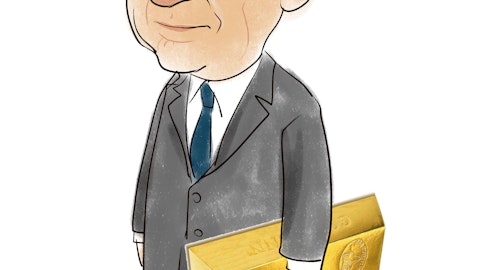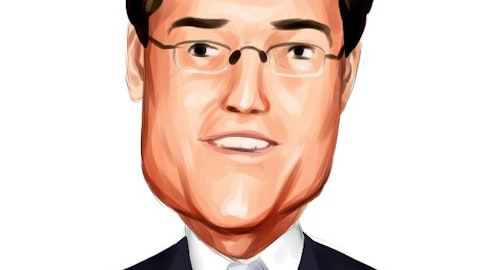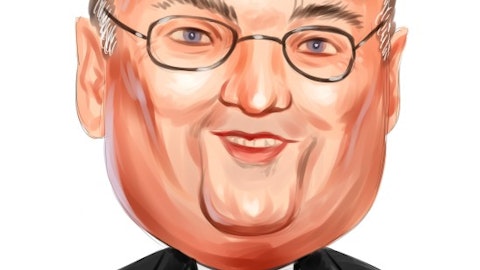Knight Capital Group Inc. (NYSE:KCG) called Royce & Associates a 10.6% shareholder at the end of June. The stake was around 10.4 million shares. Royce & Associates, the Legg Mason affiliate, is a small-cap value focused investment firm that manages various mutual funds. Other big names who owed Knight shares at the end of June were Steven Cohen and AQR Capital Management, at 2.2 million and 1.4 million shares, respectively (see all the funds owning Knight here).
Knight Capital lost $440 million in an August trading debacle that has since put a stain on the company’s reputation. Both institutions and retail investors trade via Knight’s trading platforms, and the problems on August were related to trade processing, being attributed to a technology issue that caused a flood of high volume in several stocks and disrupting normal trading activity that caused a halt in trading for a few of the NYSE listed stocks. Before the incident Knight was the market leader in providing cash equity market making.
The company traded around $10.30 before the trade malfunction, but on the back of the announcement the company fell to below $3. Another big move – down 5% yesterday – took the stock to below $2.40, but it is since back up near $2.50. The $440 million trading loss comes on the back of a $35 million loss on the Facebook IPO. A week after the $440 million loss the company took in a $400 million investment to avoid possible bankruptcy.
The $400 million in equity financing from major firms included Jefferies Group, Inc. (NYSE:JEF), The Blackstone Group L.P. (NYSE:BX), Stifel Financial Corp. (NYSE:SF), TD Ameritrade Holding Corp. (NYSE:AMTD), GETCO LLC and The Stephens Group, LLC. Knight issued 2% preferred shares, totaling 267 million, that can be converted to common shares at $1.50 per share. Jay Kaplan, fund manager at Royce & Associates, had no trouble sharing his displeasure for the situation, but also noted it was a reasonable outcome given the circumstances.
Jefferies and Blackstone, along with GETCO, took effective ownership with the most potential shares. Jefferies’ most recent quarter EPS of $0.32 included a gain of $0.08 on its Knight Capital investment, versus $0.13 expectations Revenues ex-Knight were 6% below expectations. Jefferies is relatively flat year to date, and recently saw full year EPS lowered to $1.30 from $1.35, due to weaker M&A underwriting activity. However, Jefferies does pay a 2% dividend.
Although Blackstone trades at a richer P/B (3.0) versus its top peers, the company has managed to keep a healthy pipeline of fund raising. Blackstone grew its management fee income 20% year over year in the most recent quarter, and increased AUM by 22%, giving it ample capital to deploy. 2012 after-tax tax economic net income is expected to come in between $1.30-$1.35 a share, with a strong increase in 2013, expected to come in at $2.00 a share.
Stifel and TD took less of an ownership position, with Stifel having already made key acquisitions that the company is still integrating; including Weisel Partners in 2010, and Stone and Youngberg in 2011. EPS for Stifel is expected to come in at $2.00 in 2012 and then grow to $2.60 in 2013. The company still has one of the largest U.S. equity research platforms among U.S. investment banks.
For TD, 2012 revenues are expected to be relatively flat, although the company saw a record inflow of net assets of $41.5 billion, growing 12% from last year. The company also should be able to generate more income from deposit accounts as it continues to take market share. All of this puts EPS for 2013 estimates at $1.25, versus 2012 estimates of $1.10.
Meanwhile, Knight Capital saw 22% revenue growth in 2011, but is expected to see an 18% decline in 2012. The exact impact on the firm’s reputation remains to be seen, with a big concern being weaker volume in its products offered. Knight attributes over 50% of its revenue to market making, with another big portion, around 35%, coming from institutional and sales trading, which includes full-service trade execution. Following the latest round of losses on the Facebook IPO and the August trading mishap, Knight has seen its EPS consensus estimate cut from $1.18 to negative $1.30.
Although Knight appears to be cheap on a price-to-book basis (0.2) when compared to its peers who trade at an average of 0.6, investors should remain cautious. Trading volume at Knight’s most popular trading systems reported a decline of 44% after the August issues.
Knight is expected to rebound from the estimated EPS of negative $1.30 for this year, to post a 127% growth with EPS estimated to be $0.36 in 2013. There is still much uncertainty about how clients have viewed the glitch and how vast the ultimate damage to the company’s reputation will be. However, with other big name Wall Street firms now backing the company, investors should take at least a little solace in this fact. Knight has generally traded with low volatility – a beta of 0.1 – and now trades with a sub-$1 billion market cap. This only adds insult to injury when pondering the chances that Knight can rebuild value for shareholders.






